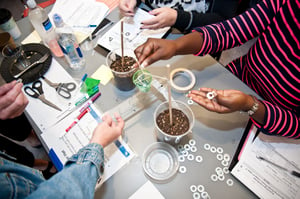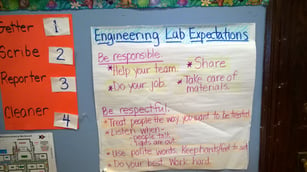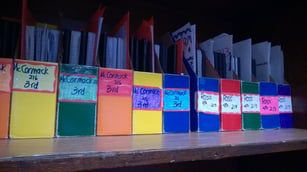 When you’re getting ready to teach an Engineering is Elementary lesson—or when you’re in the middle of a lesson that extends over more than one class period—you have lots things to organize.
When you’re getting ready to teach an Engineering is Elementary lesson—or when you’re in the middle of a lesson that extends over more than one class period—you have lots things to organize.
Patty Whitehouse is the Engineering Lab teacher at Chicago Public Schools' Goudy Technology Academy, which means she does more organizing than most teachers. Every student in the first through fourth grades comes through her lab once a week—almost 400 students total. The school uses two or three different Engineering is Elementary units in each grade, so Patty often preps five different Engineering is Elementary lessons each day! Here’s how she stays organized:
1. Make a jobs chart
 Label the seats at each table with a number. Assign each number a job. For example:
Label the seats at each table with a number. Assign each number a job. For example:
- the "group scribe" takes notes
- the "shopper" gets the materials for the group
- the "reporter" shares the group’s results with the class
- the "cleaner" cleans up at the end of the lesson
Post the jobs on a job wheel, and rotate jobs from student to student each week. With this strategy, there’s no question about who is doing what job, and everyone participates every week.
2. Use binder boxes for journal storage
 Patty’s students use black-and-white composition books as engineering journals. Between lessons, store each team’s journals together in a box labeled with the team name. Patty gets boxes of the perfect size for free from her local office supply store. (When they unpack shipments of three-ring binders, they save her the smaller boxes the binders come in.) If your office supply store won’t give you freebies, you can purchase magazine file boxes.
Patty’s students use black-and-white composition books as engineering journals. Between lessons, store each team’s journals together in a box labeled with the team name. Patty gets boxes of the perfect size for free from her local office supply store. (When they unpack shipments of three-ring binders, they save her the smaller boxes the binders come in.) If your office supply store won’t give you freebies, you can purchase magazine file boxes.
3. Do as the busboys do—use BIG dishpans
 Those big, black, shallow dishpans you see busboys using to collect dirty dishes at restaurants are also ideal for keeping a team’s materials together if an Engineering is Elementary lesson extends for more than one class period.
Those big, black, shallow dishpans you see busboys using to collect dirty dishes at restaurants are also ideal for keeping a team’s materials together if an Engineering is Elementary lesson extends for more than one class period.
You can purchase “bus tubs” at any restaurant supply company, and they’re CHEAP! Each team stows all their materials (for example, the index cards, paper cups, and weights used in lessons 3 and 4 of To Get to the Other Side: Designing Bridges) in a pan until the following week.
For Engineering is Elementary units that don’t require a large quantity of materials (for example, Water, Water Everywhere: Designing Water Filters), smaller kitchen-sized plastic dishpans also work well. You can get them at any discount department store or dollar store.
4. Make clean-up a breeze
Here’s another use for dishpans, especially if you only have one sink (or NO sinks) in your classroom, and especially if your students have been messing with mortar as part of the Engineering is Elementary unit A Sticky Solution: Designing Walls. At the end of the lesson, give each team a dishpan with an inch of warm water and a squirt of liquid soap. Students rinse their hands, dry with paper towels, and use the damp towels to wipe off the tables. Done!








